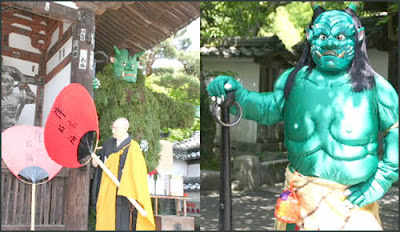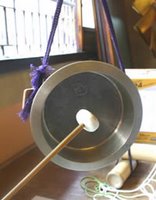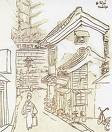[ . BACK to WORLDKIGO TOP . ]
:::::::::::::::::::::::::::::::::::::::::::::::::::::::::::::::::::::::::::::::::::::::::::::::::::
"August 1" (hassaku)
***** Location: Japan
***** Season: Mid-Autumn
***** Category: Season / Humanity
*****************************
Explanation
hassaku 八朔 (はっさく)
first day of the eighth month of the lunar calendar
. Lunar Months and the Saijiki .
Nowadays it corresponds to the first of September in its climate, and thus has become a kigo for mid-autumn.
It is the 210th day after the beginning of spring, as a seasonal festival it is
nihyaku tooka 二百十日.
From this day on, strong typhoons are hitting Japan and farmers begin fearing for their harvest (and livelyhood).
. nihyaku tooka 二百十日の風祭り wind festival on the 210th day .
- Iwate
In the rural Japan of old, the ceremonies at the seasonal changes were very important for strengthening the bonds with the gods and among the farmers.
In the old lunar calender, the very first day of a month, when there was no moon, is called SAKU 朔 or tsuitachi. The first day of the eighths month is
hachigatsu sakuhi 八月朔日, shortened to HASSAKU.
Ceremonies held on this day are also called like this. They have an old tradition in rural Japan to honour the rice paddies, which are just about beginning to bear fruit.
In rural areas, this day is also called
"special day for the fruits of the fields" (ta no mi no sechi 田美の節)
..... ta no mo no sechi 田面の節 たのものせち (tanomo)
..... ta no mi no sekku 憑の節供たのみのせっく (tanomi)
Farmers bring the best fruit of their harvest to the landowner to celebrate and wish for a good harvest coming autumn.
TA NO MO is a play with words of an invocation to the gods for a good harvest "tanomimasu".
Workers would bring small paper dolls,
hassaku ningyoo 八朔人形 to their masters in an act of gratefulness.

Grandparents would make a straw horse for a baby boy who was born in the past year. Nowadays many splendid horses are for sale.
. . . CLICK here for Photos of Hassaku dolls !
. Hassaku Dolls 八朔人形 from Sano town, Tochigi .
. Iki no hassakubina, hassaku hina 壱岐の八朔雛
hassaku Hina dolls from Iki Island .
Nagasaki
. hassakubina, hassaku hina 八朔雛 .
Fukuoka
. Regional Folk Toys from Japan .
.......................................................................
This rural custom may have spread to the nobility and townsfolk in the Edo period. It then became the custom to bring small presents to those who are close to you in your work.
They also ate and served each other sweet
Hassaku Mochi 八朔餅 dumplings in the knowledge that from now on the autumn harvest with a lot of extra hard and long work would come for most ... and maybe the taste of the mochi was a bit bitter in this expectation.
. . . CLICK here for Photos of the dumplings!
ceremony of Hassaku, hassaku no iwai 八朔の祝
Harvest Festival, Hassaku sai 八朔祭
special vessel for giving a present to the wet nurses who feeded a person as a baby, other than the own mother,
ebokai 絵行器(えぼかい)
Bokai were special vessels for carrying food around.
 © PHOTO ainu museum japan
© PHOTO ainu museum japan
In these vessels, food and the following handmade animals were given as presents:
"manmade colored sparrow", tsukuri suzume 綵雀(つくりすずめ)
"manmade pheasant", tsukuri kiji 造り雉(つくりきじ)
"manmade heron", tsukuri sagi 造り鷺(つくりさぎ)
"princess melon doll", hime uribina 姫瓜雛(ひめうりびな)
"princess melon day", himeuri no sekku 姫瓜の節句(ひめうりのせっく)
Small white melons are painted with a powdered white face, cloths are draped around bamboo sticks to make them look like little princesses. This is a custom still practices in Kyoto.
special kimono worn for this day, hassaku no kosode
八朔の白小袖(はっさくのしろこそで)
..... for men the black official kimono with the family crest. Since it is still rather hot on this day, men sweat a lot during the ceremonies.
Even the ladies of the Yoshiwara quarters would wear light, often white robes or large white belts and visit their sponsors. Nowadays, Hassaku is celebrated in the Gion quarters of Kyoto, where the maiko walk around in light white kimono.
 © PHOTO http://blog.goo.ne.jp/sya5017
Click HERE for some photos of the girls !
white ceremonial hat, hassaku no shiro katabira
© PHOTO http://blog.goo.ne.jp/sya5017
Click HERE for some photos of the girls !
white ceremonial hat, hassaku no shiro katabira
八朔の白帷子(はっさくのしろかたびら)
Worn during the Edo period by the officials and regional lords for this festival.
:::::::::::::::::::::::::::::::::::::::::::::::::::::::::::::::::::::::::::::::::::::::::::::::::::::
The term
hassaku refers to the first day of the eight lunar month and the term
hassaku matsuri encompasses a variety of observances held to ask the gods (kami) for a plentiful harvest.
The
hassaku matsuri at Matsu-no-o Shrine (Matsunoo Taisha) in Nishikyō Ward, Kyoto City, Kyoto Prefecture is held on the first Sunday of September-which is actually numerically one month later than the traditional first day of the eight lunar month. The
Tanomi shinji (田の実) held on September 13 at Aguchi Shrine in Sakai City, Osaka Prefecture, is also a hassaku festival, in which local farming households offer the first ears of rice harvested.
Likewise, on
September 1 Iwakiyama Shrine in Iwaki Town, Naka-Tsugaru County, Aomori Prefecture, and Dewa Sanzan Shrine in Haguro Town, Higashi-Tagawa County, Yamagata Prefecture perform rituals called
Tanomosai (田面祭) to secure a bountiful harvest. Moreover, Ono Shrine in Shiojiri City, Nagano Prefecture, holds a similar ritual on hassaku called
Tanomosai (田母祭), whereas a Hassaku matsuri is held on hassaku both at Ōhirasan Shrine in Hirai District, Tochigi City, Tochigi Prefecture, and at Ōarai Isozaki Shrine in Ōarai Town, Higashi-Ibaraki County, Ibaraki Prefecture.
These and other cases demonstrate the ritualization of the lay custom of offering newly harvested grains to kami on hassaku and "entreating" (tanomu) them for a bountiful harvest.
© — Mogi Sakae, Kokugakuin University.

八朔祭(8月31日)
Hassaku Ceremony August 31
Dewa Sanzan Shrine in Haguro
 Hassaku matsuri at Oishi Fudo-In
Hassaku matsuri at Oishi Fudo-In
大石不動院
Mie prefecture, Matsuzaka town, Oishi village
This festival has a tradition of more than 200 years.
Prayers are said to prevent damage from storm and water, for a good harvest, for the safety of the region and for a prosperous family.
It starts on August 31 and the main event in on September 1.
source : hudouinn
:::::::::::::::::::::::::::::::::::::::::::::::::::::::::::::::::::::::::::::::::::::::::::::::::::
Tea Ceremony
When Tokugawa Ieyasu entered the castle of Edo in 1590, his retainers and the feudal lords were invited for a congratulating ceremony. Red ceremonial rice (sekihan) was served as food for the townspeople.
In memory of this day, the students of a tea ceremony master come to visit him on this day.
Special food was served on this occasion, a rice gruel called
O-bana no kayu 尾花の粥
..... obana gayu 尾花粥(おばながゆ), obanagayu小花粥(おばながゆ)
..... susuki gayu 薄粥(すすきがゆ)
Roasted ears of the susuki grass were mixed in the rice gruel. It was supposed to have medical properties to keep you fit for the harvest season.
These words are also kigo for the season.
For the Sen school of tea, there is also a special tea ceremony on this day (and the first of January), when the ten supporting craftsmen (juushoku 十職) of this school are invited to celebrate the bond of their continuous support.
The long bonds between the Raku family, making tea cups (rakujawan 楽茶碗) and others are well known.
The kettle used for this tea ceremony is called
hassaku gama 八朔釜
External LINK
Tea Ceremony at Ura Senke with the 10 Artisans
... ... ...
In the creative aspect of the art, it is the iemoto who sanctions new utensils and styles for use within the school and can forbid the use of unrecognized objects and utensils made by unsanctioned craftsmen. Utensils are developed through relationships with
established craft families (Senke Jushoku) as well as new artisans whose work meets his standards.
Each iemoto establishes his preferences (konomi mono) in utensil types and designs, these then become part of the utensil repertoire available for students. Through authentication (hakogaki), he establishes a sense of taste. Other ways of exerting influence over the utensils used for chado are through officially recognizing certain craftsmen and utensil dealers and encouraging members to patronize these people, by engaging in utensil sales, by assisting museums and other exhibitors in displaying utensils for public viewing, by providing assistance to scholars and researchers of the arts, and through financial support to individuals and institutions which promote the study and practice of chado.
By being the authority and definer of chado's symbolic content, the iemoto perpetuates the art through an hereditary system that enables continuity and creativity.
Read more here
© By Barbara Lynne Rowland Mori
*****
Tea Ceremony Saijiki 茶道の歳時記
:::::::::::::::::::::::::::::::::::::::::::::::::::::::::::::::::::::::::::::::::::::::::::::::::::
Hassaku Doll Festival at Nio Village
仁尾八朔人形祭り
 © PHOTO http://gamma.de.takuma-ct
Click HERE to see more photos !
*****************************
Worldwide use
*****************************
© PHOTO http://gamma.de.takuma-ct
Click HERE to see more photos !
*****************************
Worldwide use
*****************************
Things found on the way
*****************************
HAIKU
八朔や治水神社の日照雨
hassaku ya Chisui Jinja no sobae ame
Hassaku Ceremony !
at the shrine Chisui
it rains and shines
Gendai Haiku
(Tr. Gabi Greve)
Click HERE for photos of this shrine !
:::::::::::::::::::::::::::::::::::::::::::::::::::::::::::::::::::::::::::::::::::::::::::::::::::::
八朔や馬具に結はへし守札
hassaku ya bagu ni yubaeshi mamori fuda
hassaku ceremony -
I bind the lucky talisman
to the harness of a horse
Shimogawara Shoo 下河原勝
(Tr. Gabi Greve)
*****************************
Related words
***** Hassaku orange (hassaku kan 八朔柑 or zabon)
a citrus fruit
kigo for spring
Look at some PHOTOS HERE !
八朔や分けてあげたい自由時間
hassaku ya wakete agetai jiyuu jikan
hassaku orange -
I would like to share it,
my free time
Shizuko しずこ
(Tr. Gabi Greve)
xxxxxxxxxxxxxxxxxxxxxxxxxxxxx
***** Hassaku Plums (hassaku bai 八朔梅)
"red from China" kara kurenai 唐紅花 からくれない
"red from Korea" kara kurenai 韓紅花
kigo for mid-autumn
A kind of plum that came via China to Japan a long time ago. It flowers arount the first of August, with a specially full blossom (yae 八重) and the flowers might last as long as December.
 Teabowl called "Korean Red" 韓紅花 からくれない Rose Red
Teabowl called "Korean Red" 韓紅花 からくれない Rose Red
© PHOTO ちゃわんあそび
*****
Fields, rice fields, rice paddies (ta) and haiku
*****
Red ceremonial rice (sekihan)
:::::::::::::::::::::::::::::::::::::::::::::::::::::::::::::::::::::::::::::::::::::::::::::::::::
kigo with moxabustion
. . . . . . . . . August second
getting a moxabustion on August second
nochi no futsuka kyuu 後の二日灸
kigo for mid-autumn
getting a moxabustion on February second
futsuka kyuu 二日灸
spring moxabustion, haru no kyuu 春の灸
day for the moxabustion, kyuu suebi 灸据え日
..... yaitobi やいと日
kigo for mid-spring
 © PHOTO Copyright(C)1995-2006 Echizenya Co.,Ltd.
© PHOTO Copyright(C)1995-2006 Echizenya Co.,Ltd.
This day relates to the second day of the second month, according to the Asian lunar calendar. If you receive a moxabustion on one of these days, it is supposed to be a hundredfold more powerful for your health.
Modern dates may place this custom on the second day of March and September.
Moxibustion / the Wikipedia
Oku no Hosomichi
- - - Station 1 - Prologue 出発まで - - -
with a moxa on his shins . . .
. Matsuo Basho 松尾芭蕉 - Archives of the WKD .
ashi no sanri 足の三里 the point SANRI on the leg, ST36
there is another SANRI one on the arm.
.................................................................................
yaitobana 灸花 (やいとばな) "moxa flower"
hekuso kazura 屁糞葛(へくそかずら) "smelling fart vine"
Paederia scandens
plant kigo for late summer
doyoo kyuu, doyookyuu 土用灸 (どようきゅう)
moxabustion on the doyoo day
... doyoo mogusa 土用艾(どようもぐさ)
... hooroku kyuu 焙烙灸(ほうろくきゅう) moxa with a horoku pot
kigo for late summer
hooroku plates for moxibustion ほうろく灸
and Jizo Bosatsu
 Hitotsu Yaito ひとつやいと one moxabustion
Hitotsu Yaito ひとつやいと one moxabustion
for the tired monks and lay people. With the wish for health in the coming summer.
at temple Zuiryu-ji 瑞龍寺 Zuiryuuji.
Takaoka town, Toyama prefecture 富山県
.................................................................................
kankyuu 寒灸 かんきゅう moxabustion in the cold
... kan yaito 寒やいと(かんやいと)
kigo for late winter
.................................................................................
kigo for the New Year
初灸 はつきゅう first moxabustion
... hatsu yaito, hatsuyaito 初やいと
yaitoshoogatsu, yaito shoogatsu 灸正月(やいとしょうがつ)
moxabustion on the New Year
.................................................................................
 source : michiko328
月花の愚に針たてん寒の入
source : michiko328
月花の愚に針たてん寒の入
tsuki hana no gu ni hari taten kan no iri
Matsuo Basho 松尾芭蕉、1692, age 49
into my moon and flower
folly, I'll drive a needle:
start of deep winter
Tr. Barnhill
acupuncture
for flower-moon foolishness -
the cold weather's sting
Tr. Addiss
MORE
. - Basho and the Acupuncture needles - .
. Matsuo Basho 松尾芭蕉 - Archives of the WKD .
:::::::::::::::::::::::::::::::::::::::::::::::::::::::::::::::::::::::::::::::::::::::::::::::::::::::::::::::::
やまの娘に見られし二日灸かな
yama no joo ni mirareshi futsuka kyuu kana
getting my February moxabustion -
a maiden from the mountains
looks on
Takahama Kyoshi 高濱虚子
xxxxxxxxxxxxxxxxxxxxxxxxxxxxx
でこぽんのでこぽんでこの二日灸
dekopon no dekopon deko no futsuka kyuu
pon pon and again
pon pon on my forehead -
moxabustion on the second day
Gendai Haiku Collection
(Tr. Gabi Greve)
xxxxxxxxxxxxxxxxxxxxxxxxxxxxx
From the opening passage of
Basho's "Oku no Hosomichi:"
"Possessed by the spirits of roving which wrenched the heart, beckoned by Doosojin, unable to settle hand on anything, I mended a tear in my pants, replaced a cord in my hat,
burned my shins with moxa, and then with the moon of Matsushima rising in my mind..."
(trans. by David Barnhill)
Doosojin, the Wayside Gods and Haiku 道祖神
::::::::::::::::::::::::::::::::::::::::::::::::::::::::::::::::::::::::::::::::::::::::::::::::::
WASHOKU
Hassaku Oranges and other food
*****
. Mugwort (yomogi) for moxabustion .
*****
. PLANTS - - - the Complete SAIJIKI .
. . .
. AUTUMN
the complete SAIJIKI
. Dates used in Haiku and Kigo .
:::::::::::::::::::::::::::::::::::::::::::::::::::::::::::::::::::::::::::::::::::::::::::::::::::::
[ . BACK to DARUMA MUSEUM TOP . ]
[ . BACK to WORLDKIGO . TOP . ]
:::::::::::::::::::::::::::::::::::::::::::::::::::::::::::::::::::::::::::::::::::::::::::::::::::::























































